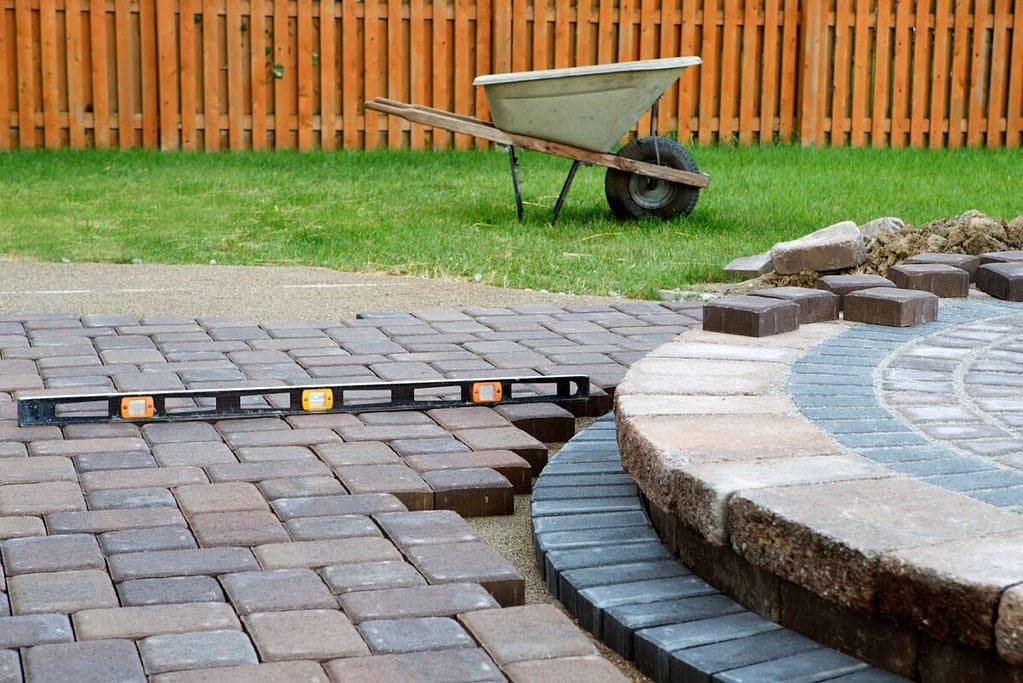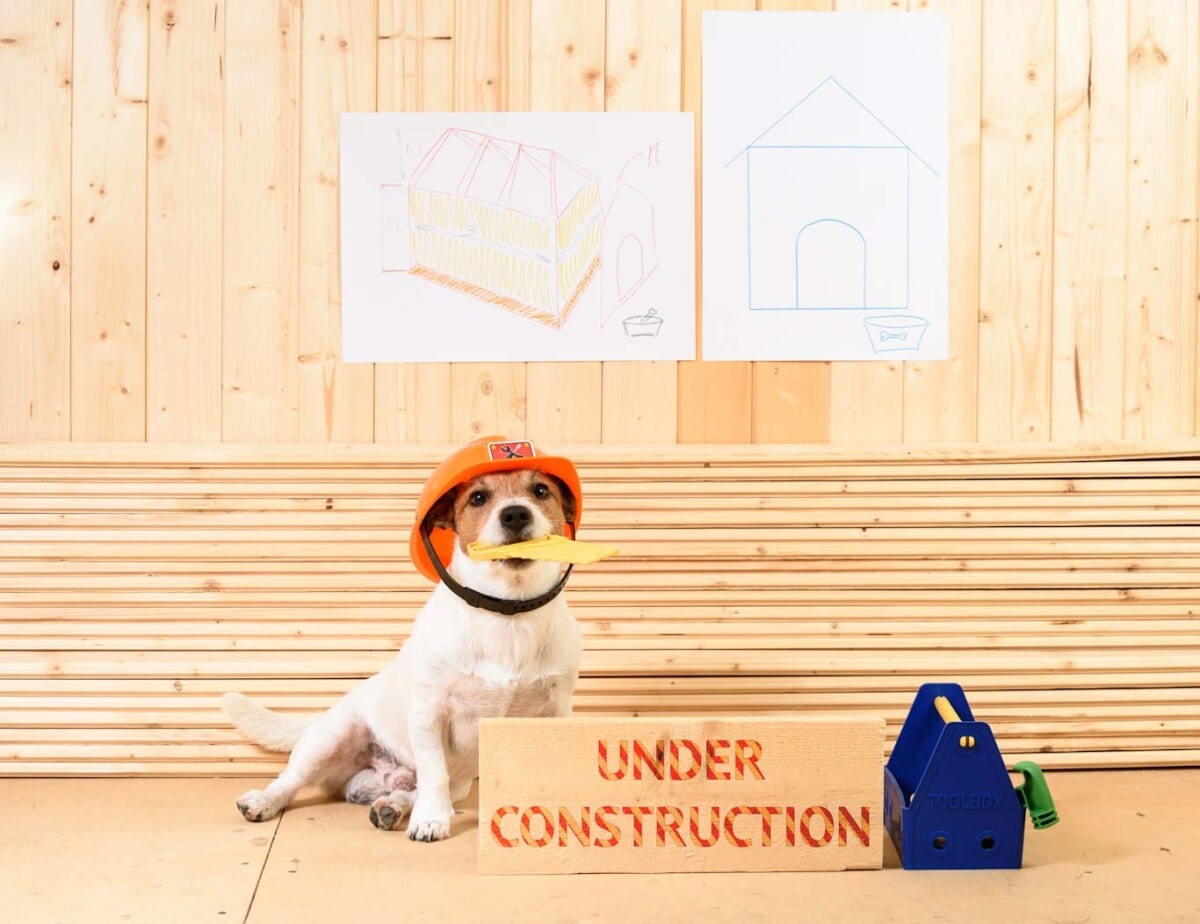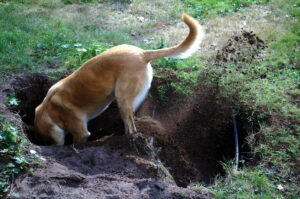Whenever you make or buy a dog house, there’s always the question of what you should put your dog house on. What sort of foundation would be required for a dog house? And what would work best? Well, that’s why we’re here today, isn’t it? We’ll give you some awesome dog house foundation tricks that save you time and money. Let’s dig in (no pun intended).
Want To Listen To This Article Instead?
Considerations For Foundation Type Selection
There are several easy-to-create foundations for dog houses. The type you choose will depend upon a few different factors.
Permanence.
How long do you want the dog house to be in your chosen place? Will the dog house be a permanent yard fixture, or will you make it mobile so you can choose to change its location?
Type of Earth.
The type of ground you are setting the dog house on top of will also play a factor in deciding the type of foundation to choose. For example, soft, wet yards should have a well-drained, raised foundation to avoid a wet, rotting dog house (assuming a wood dog house construction).
Grade of Slope.
Again, the ground is what we’re looking at here, so we need to consider the yard’s slope and, thus, the drainage. The slope will play a factor in how we landscape the area.
Kennel or Dog House.
You might be keeping dogs outside year-round if you live in a warmer climate than I do. You may set up a kennel with a dog house attached or inside a caged kennel area if that’s the case. The size of the kennel, where you intend the dog to ‘do it’s business’, and how long the dog is to remain in the enclosure all play essential factors in how you will set up the dog house foundation.
Size And Weight Of Dog House.
Naturally, the size and weight of any structure will determine the strength of the required foundation. I just make it simple and use an overkill technique. If it’s overkill, it’s probably good enough.
Climate.
If the ground goes through a freeze-and-thaw cycle each year, you need to consider this when setting a foundation. The type of earth plays into this one heavily as well. It is especially essential in areas not well drained and prone to high levels of ice within the soil due to high water levels.
Types Of Ground
Sand – Can be difficult; recommend screw-jack support
Dirt – Most common. Use most types of foundations. Drainage top concern, along with possible sinking or settling of the foundation, depending on the type.
Mud/Wet Dirt – Difficult to secure. Build up with coarse gravel until at least 2 inches above water level for a medium-sized dog house. Ideally, set a secondary foundation or support on top of the gravel. As an alternative, support dog houses with stilt-style foundations, such as using screw-jack foundation supports. See recommended foundation support at the end of the article.
Swampy/Marshy – Not advised to set a dog house on a marsh. Find some solid ground.
Water – Forget it. Actually… you could make a floating dog house, I suppose. Perhaps something like a pontoon boat for a base? Okay, it would be smaller than a pontoon boat, obviously, but it would be pretty cool if you have a cottage and a dog that loves swimming.
Foundation Types
Concrete
Concrete is the ideal permanent foundation type. And did you know that concrete is relatively inexpensive but quite labor-intensive to fabricate? Concrete mix bags can be purchased at most major hardware stores in the US and Canada anyway and run from $4 – $7 per bag. A medium dog house typically uses 4 – 6 bags to make a thin slab foundation.
A lot of preparation is required when fabricating a concrete foundation for your dog house. The dog house foundation is not intended to crack, sink or settle, so we need to look at the type of ground and ensure we have the best possible drainage. To do this, in most dirt types, here’s what I would do to prepare for concrete.
Concrete Method Tips
First, I would dig down about a foot. It tells me what kind of dirt I’m dealing with. I’m looking for dirt with a high content of clay. This type of dirt is super compacted and hard to dig in. If this is the case, I might only dig about 6 inches (15 cm). Next, I would lay down about 4 inches (10 cm) of coarse gravel.
Next, I would then pour a layer of concrete over that to just cover the gravel with about a 1” uniform layer of concrete. Because I’m not a fan of shifting/cracking concrete, I would then lay a wire mesh on the fresh 1” of concrete and pour another inch of concrete on top of that. This would leave me with 4” of coarse gravel, permeated by 2” of concrete with wire mesh in the middle of the concrete. I would do this for a medium-sized dog house in hard, compacted soil.
For less dense soil, just dig deeper and add a deeper layer of gravel. Make sure to tamp the gravel down to pack it down before pouring any concrete on top. Many will say that the wire mesh is excessive and unnecessary for such a small slab as you would make for a dog house foundation. I’m afraid I have to disagree because adding mesh is so stupidly simple and barely costs more than a few dollars, and it adds strength to hold the concrete together. That’s why I say, for a few bucks, why not? If it’s intended to be permanent, make it last. That’s my philosophy, anyway.
Patio Stone

As shown above, I would use the same method for foundation prep for concrete. Patio stones are basically just slabs of concrete that are already pre-dried. The problem with patio stones is that if you don’t have a good base of gravel underneath, they will settle into the dirt and, over a year, can become quite crooked and off-level. I’ve also had problems with patio stones cracking, although that’s usually due to excessive weight on them.
Gravel
A gravel foundation is fine if you still support the dog house where it meets the gravel. If the dog house is on pole-like stilts, it will settle into the gravel, so a wide footprint is required if a stilt-structured design is a case.
Gravel provides excellent drainage and, if patted down, can provide a stable and secure base for a dog house. There are a couple of considerations, though.
- The gravel should be made into a sort of ‘hill’ or slightly raised above the level of the dirt. This will improve drainage and airflow under the dog house.
- The gravel should not include quartz or be of a pure limestone composition. Quartz gravel is often containing multiple sharp shards. Treat quartz like broken glass. You wouldn’t want your dog to walk on broken glass, just as you would not do barefoot yourself (I would hope).
Limestone won’t be sharp like quartz. The issue with limestone is that it is pretty basic in terms of pH. When water is added to limestone, the stone can slowly dissolve into the water, making the water a base that can irritate or even chemically burn the skin. It can also alter the pH of the surrounding soil, which can harm your grass or garden.
Recommended Gravel: ½ to ¾ inch (1-2 cm) sized gravel for most of the depth and a 1-inch (2 – 3 cm) layer of pea-sized gravel on top. The gravel should be composed of granite for best results. Granite will last a million years or more and won’t affect surrounding pH.
Cinder Block

Cinder blocks work fine as long as you’ve got a compacted base for them to sit on. Also, you may need to consider what size of cinder block you use, or you might need a ramp up to the dog house door. There are thin cinder blocks about 3 inches deep, so those might work fine.
The consideration with cinder blocks or any brick or block is the same consideration we have for using patio stones. These are heavy, solid blocks. You can lay them directly on dirt, but don’t expect them to stay level or on top of the soil for long. Any type of heavy block or stone will always sink into the dirt. Think of dirt as a really, really thick liquid. Stones always sink in liquid, and likewise, they also always sink in the dirt. It just takes a lot longer, that’s all.
So, if you want to use blocks, you’ll need to dig down a bit and use gravel to make a solid, well-draining foundation for the blocks.
Timber/Wood
Timber or wood is the most common building material for a dog house if you are building it yourself. Therefore, wood is the most likely element of the dog house to be touching the ground beneath it. I do not recommend using wood as a foundation unless you use what I like to call the railroad technique.
The Railroad Technique
First, just like with concrete, dig and form your gravel layer. Bring the gravel layer 1 inch (2 cm) below the dirt level.
Next, lay 2 ‘greased’ wood beams. When I say greased, I mean that the wood has to be stained to prevent rot and coated in creosote to protect the wood further against moisture. I would not use creosote, though, as the wood will be near my dog. I only use stains that would be safe for a wooden deck where children could play. Any stain safe for wood people will touch would also be suitable for your dog house wood. After staining, I’ll usually paint the wood with sealing coats and weather-proofing paint.
Pat the two beams down into the gravel and top up the gravel around. If you’re using a nice thick beam like a 4” x 4”, then the exposed beam’s top surface should be just above the level of the gravel surrounding it. And the gravel should be slightly raised to the ground around it.
Plastic
I’m not a plastic fan, so I won’t recommend its use. However, if you were to use plastic as a foundation material, I would recommend using a solid composite beam and the railroad technique shown above. Minus the stain and paint, of course.
SUPER TIP: Use A Dog House Foundation Ground Screw

You can skip the mess with these Mayne 580D-BK No Dig Ground Anchors. Four of these and no digging involved, no mess, no concrete. It takes a bit of strength to power four of these deep into the ground, but it’s well worth it. They can fit a 4″ x 4″ post, so you can run two as a ‘railroad’ parallel foundation for your dog house.
More From Dog House Times
- A Perfect ‘Green’ Garden Dog House And Landscape
- Dog House Reno – Insulating A Dog House
- How To Get Your Dog To Use Its House- A Training Guide
- Great Common Plants Safe For Dogs And Some That Aren’t
- Dogs And Marijuana – A Guide For Dog Owners
- The Best Farm Dog Breeds
- The Top Dog House Types For Each Climate
Some Dog Breeds You Might Find Interest In
- Dalmatian (Dog Breed Information)
- Gordon Setter- (Dog Breed Information)
- Greater Swiss Mountain Dog (Dog Breed Information)
- Alaskan Malamute (Dog Breed Information)
- Pointer (Dog Breed Information)- The Bird Dog
- German Pinscher Dog Breed Information
- Finnish Spitz (Dog Breed Information)
- Basenji Dog (Breed Information)
- Irish Wolfhound- (Dog Breed Information)





